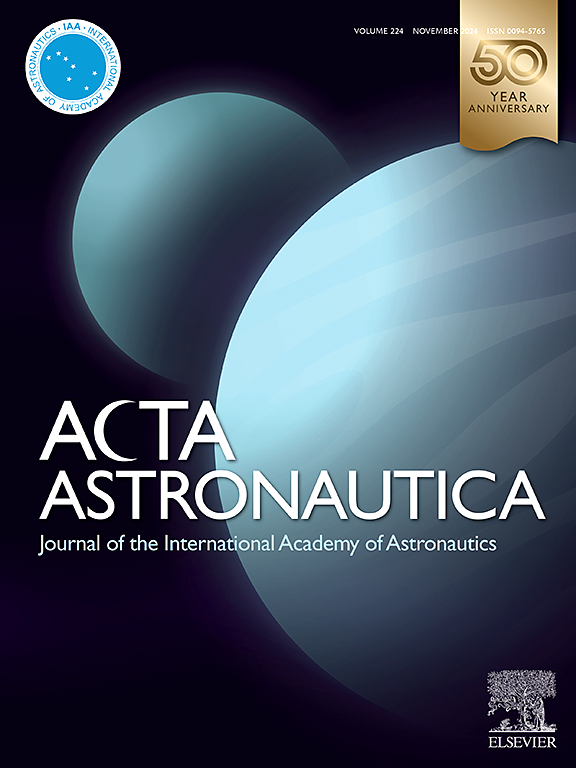Hypergravity influences mouse erythrocyte membrane lipid composition and antioxidant potential
IF 3.1
2区 物理与天体物理
Q1 ENGINEERING, AEROSPACE
引用次数: 0
Abstract
To support safe human space exploration, it is important to understand how different effectors, including gravitational forces, influence living organisms. Indeed, altered levels of gravity affect the physiological function of multiple cells, tissues, and organs in living organisms. Previous studies suggested that microgravity modifies plasma membrane permeability and cellular metabolism in erythrocyte, modifying cholesterol and phospholipid levels. However, to support human safe space exploration, it is also relevant to understand the effects of hypergravity. Therefore, the aim of this study was to investigate in vivo the impact of hypergravity on lipid phenotype and oxidative stress in mouse erythrocytes.
Animals were housed in the Italian Space Agency's Mice Drawer System (MDS-ASI), a facility designed to house rodents on the International Space Station (ISS) and adapted by Thales Alenia Space to the Large Diameter Centrifuge (LDC-ESA), to expose mice to a 3×g environment for 14 days. After exposure, a tissue-sharing protocol allowed us to purify and analyze erythrocytes.
Our results show that the exposure of mice to altered gravity induced the reduction of unsaturation degree in erythrocyte membranes correlated to a lower stearoyl-CoA desaturase (SCD-1) activity. Moreover, the hypergravity induced both a decline in antioxidant defences, indicated by the significant decrease in total glutathione, and a grow of the inflammatory status, supported by an increase in the AA/EPA ratio.
超重力影响小鼠红细胞膜脂质组成和抗氧化潜能
为了支持安全的人类空间探索,重要的是要了解包括重力在内的不同效应器如何影响生物体。事实上,重力水平的改变会影响生物体中多种细胞、组织和器官的生理功能。先前的研究表明,微重力改变了红细胞的质膜通透性和细胞代谢,改变了胆固醇和磷脂水平。然而,为了支持人类安全的太空探索,了解超重力的影响也是相关的。因此,本研究的目的是研究体内超重对小鼠红细胞脂质表型和氧化应激的影响。动物被安置在意大利航天局的老鼠抽屉系统(MDS-ASI)中,这是一个为国际空间站(ISS)上的啮齿动物设计的设施,由泰雷兹阿莱尼亚空间公司改装成大直径离心机(LDC-ESA),将老鼠暴露在3×g环境中14天。暴露后,组织共享协议允许我们纯化和分析红细胞。我们的研究结果表明,小鼠暴露于改变重力诱导红细胞膜不饱和度的降低,这与硬脂酰辅酶a去饱和酶(SCD-1)活性降低有关。此外,超重诱导抗氧化防御能力下降(表现为总谷胱甘肽的显著减少)和炎症状态的增加(表现为AA/EPA比值的增加)。
本文章由计算机程序翻译,如有差异,请以英文原文为准。
求助全文
约1分钟内获得全文
求助全文
来源期刊

Acta Astronautica
工程技术-工程:宇航
CiteScore
7.20
自引率
22.90%
发文量
599
审稿时长
53 days
期刊介绍:
Acta Astronautica is sponsored by the International Academy of Astronautics. Content is based on original contributions in all fields of basic, engineering, life and social space sciences and of space technology related to:
The peaceful scientific exploration of space,
Its exploitation for human welfare and progress,
Conception, design, development and operation of space-borne and Earth-based systems,
In addition to regular issues, the journal publishes selected proceedings of the annual International Astronautical Congress (IAC), transactions of the IAA and special issues on topics of current interest, such as microgravity, space station technology, geostationary orbits, and space economics. Other subject areas include satellite technology, space transportation and communications, space energy, power and propulsion, astrodynamics, extraterrestrial intelligence and Earth observations.
 求助内容:
求助内容: 应助结果提醒方式:
应助结果提醒方式:


